Dental implants
Placement of dental implants:
a speciality of the Rhône Dental Clinic
At the Rhone Dental Clinic, dental implantology is an important branch that has become one of the clinic’s specialities over time and in terms of the number of cases.
Our clinic approaches this discipline of dental surgery within the framework and consensus validated by the best specialists on an international scale, a true “Golden Standard” guaranteeing our patients implant placement exclusively by dentists.
At the first consultation, your dentist will establish a diagnosis with the clinic’s multidisciplinary medical team (dentists, maxillofacial surgeons, anaesthetists, prosthetists, dental assistants and nurses) and will gather all the information relating to your situation as well as the necessary digital imaging.
Depending on the case, the constraints, and the aesthetic problem, our clinic is able to enter into a procedure of immediate care so that the patient can leave with temporary fixed prostheses.
Our dental clinic in Geneva adapts to the most demanding schedules and private requirements of each patient. We guarantee a strict punctuality and offer an emergency service in case of necessity.
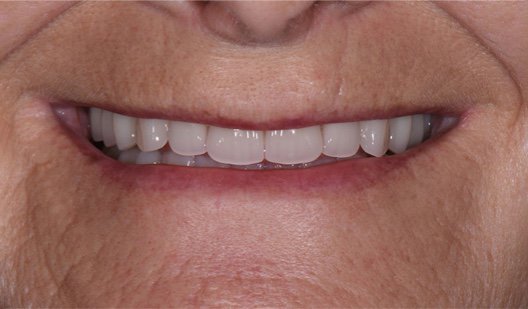
Summary
1. A multi-disciplinary team to ensure patient comfort
Although the practice of implantology may seem to be becoming commonplace, the placement of an implant remains a surgical act that requires a gesture of great precision.
The root of the tooth being the foundation of a functional, postural and aesthetic balance, its replacement by an implant mobilizes a broad set of knowledge and skills.
Only this multidisciplinary approach will guarantee the success and durability of the treatment.
The dental implant is an artificial root of the tooth in the form of a screw (usually made of titanium) whose abutment is intended to create the connection with a prosthetic structure (crown).
Dental implants are cylindrical or conical in shape, with a length and diameter chosen by the dentist, depending on the quality of the bone. Following a precise diagnosis and an overall reconstruction plan, the surgical procedure consists of placing the implant in the bone of the mandible or jaw to replace the missing tooth.
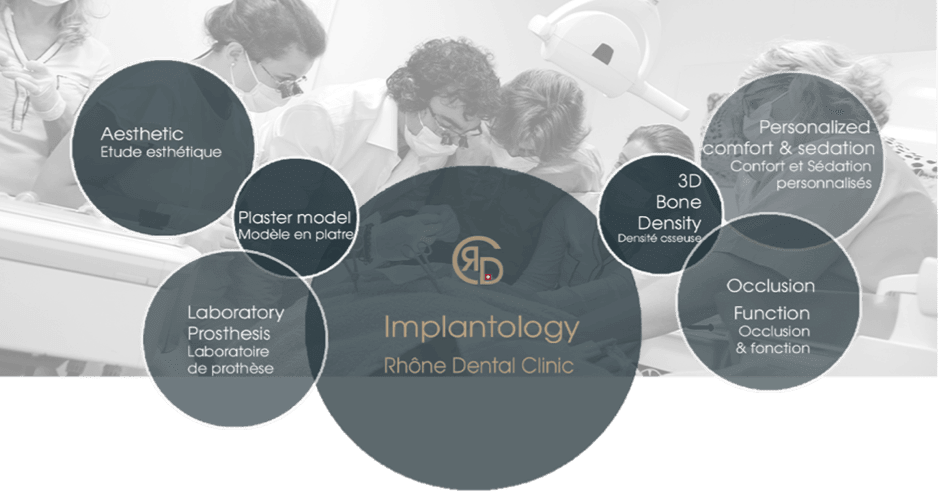
2. Dental implant protocol at Rhône Dental Clinic
Made in our integrated laboratory, the crown will be added separately to the implant (screw and abutment), thus constituting the whole of the prosthetic realization.
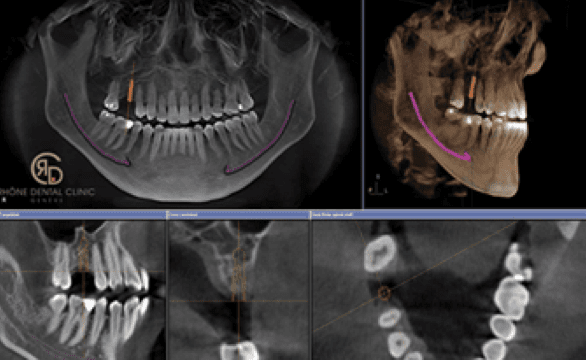
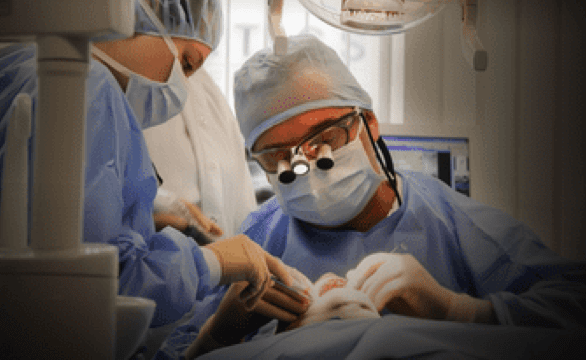
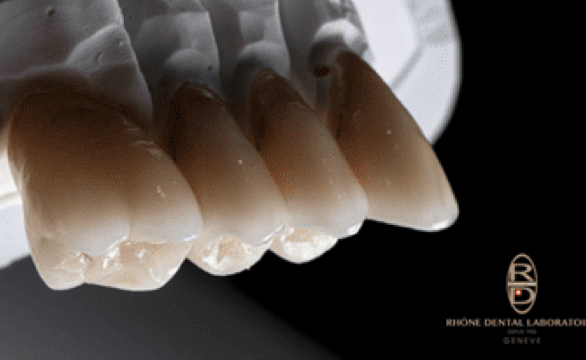
Rhône Dental Clinic implantology protocol aims to take into account the context of the patient and the procedure as a whole to ensure optimum comfort and precision.


3. Dental implant emergency: immediate treatment by our dentists
Design of temporary teeth in 24 hours
Based on the experience of numerous immediate treatments, the Rhone Dental Clinic protocol allows several steps to be combined for the placement of implants and fixed provisional teeth, simultaneously with sedation and treatment allowing recovery the day after the surgical procedure.
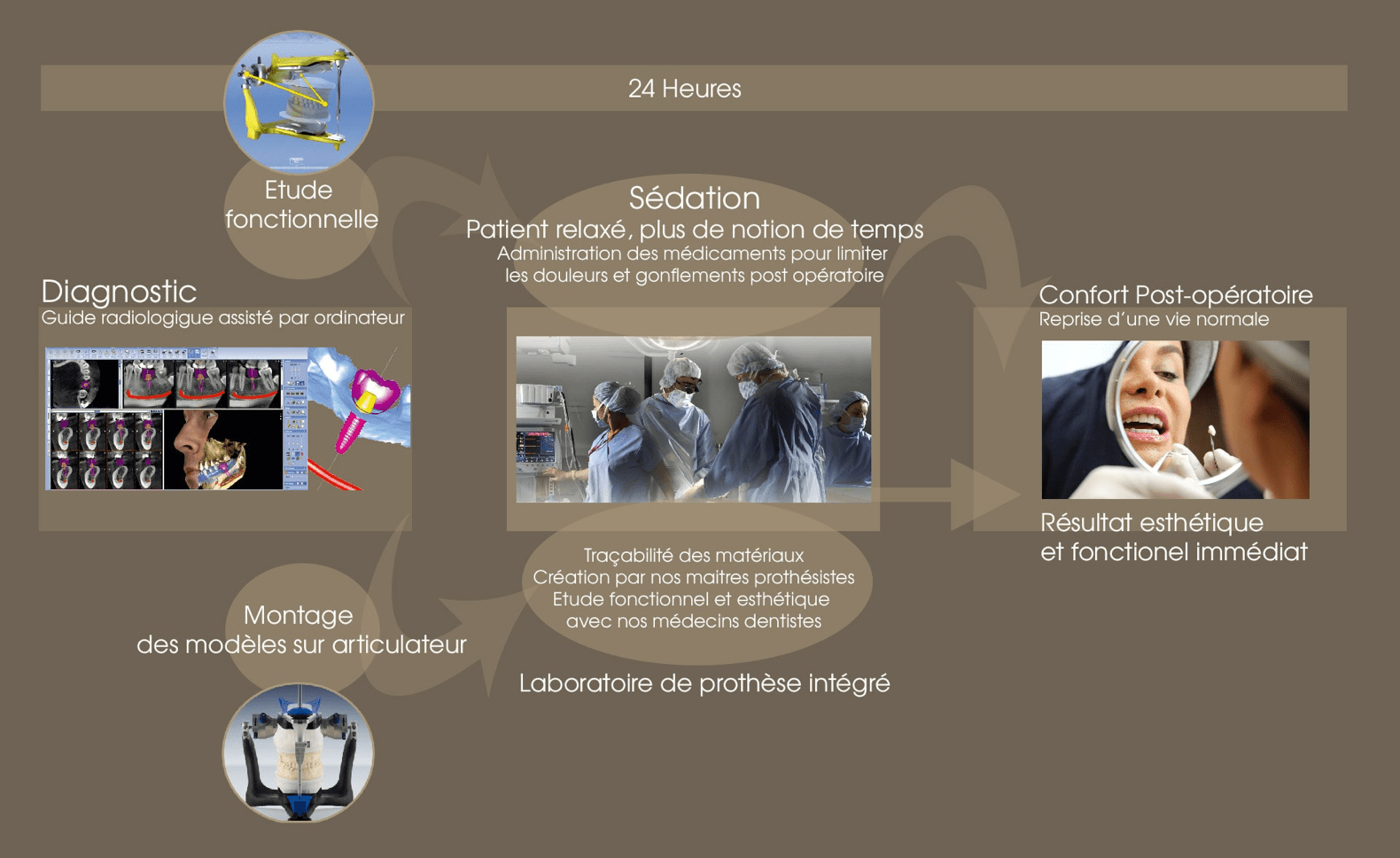
The placement of approximately 8 to 10 implants, distributed over the arch, allows for the best possible balance of occlusal loads and improves the success of the immediate loading: the pre-implant diagnostics will define the treatment plan. A list of contraindications will be established (such as bone volumes or certain heavy pathologies) to facilitate the success of the protocol.
The study of occlusal forces and the aesthetic simulation will allow the design of a tri-dimensional radiosurgical guide respecting the planning of the implants to the tenth of a millimetre. This is a replica of the future prosthesis that the surgeon will position in the patient’s mouth at the time of the operation. This “pre-prosthesis” will guide the surgical gesture, according to the computer planning which will have been made upstream, thus guaranteeing the optimal integration of the implants in the vestibular bone volume.

Procedure for emergency implantology
D-Day
Approximately two to three tubes of blood will be collected by a nurse, centrifuged and then re-injected at the end of the surgery releasing a fibrin-rich platelet concentrate. This technique called PRP will accelerate the healing process and seal the bone walls around the implant. Mixed with bone powder extracted from the root canal cavity to receive the implant, the PRF will promote bone density to support the implant.
In some cases, to avoid bone grafting, our doctors will add artificial (allogenic) bone powder with the PRP to reinforce the bone volume. During the administration of the sedation protocol, the medical team groups the different procedures to load the implants immediately. The gum is incised and cleared, freeing access to the bone site where the implant is to be placed. The successive passage of drills of different diameters allows to prepare the housing in which the implant is then placed.
The temporary teeth will be loaded on the same day. In the case of a full bridge (requiring more time to manufacture) it will be screwed in the day after the operation.
Day D+1
The patient returns to a normal social and professional life immediately. Osseointegration (bone healing) takes between 6 and 12 weeks. Before this time, stabilisation is only ensured by the anchoring of the implant. Until the third week, the implant approaches are subject to bone movements, which is why it is essential to load the implants as soon as possible (maximum 72 hours) and not to remove the prosthesis during the healing period. The patient is recommended to eat a soft diet for the first 6-10 weeks.
Day D+90
Taking of impressions, aesthetic study, choice of the definitive shade and functional assessment (record of information from the wearing of the provisional prosthesis). Manufacture of the definitive prosthesis integrating the prosthetic pre-assessment and the patient’s feedback. Fitting of the final prosthesis, the patient will regain the same functions as his or her initial teeth when young. Both mechanically and aesthetically the patient will no longer have any discomfort, psychologically and socially, the harmony of a successful smile will release more confidence.
4. What is dental implant surgery ?
The placement of a dental implant is a procedure performed under local anaesthesia. It consists of removing the gum, then making an implant hole in the bone using specific and calibrated instruments. The implant is then screwed into the jawbone to stabilise it. The gum is then replaced and sutured.
Preparation of the implant hole
After placement, the bone will heal on the dental implant and fuse to the surface of the implant. This is called osseointegration.
A healing period of 2 to 4 months is necessary to achieve this osseointegration. In the case of bone reconstruction, the healing period for dental implants is longer and can be from 4 to 8 months.
Two main types of implants are used depending on the indications:
- Buried implants : they are placed in the bone and covered by the gum in a first step. A second uncovering operation is carried out, after their osseointegration, for the installation of a healing screw which passes through the gum.
- These implants are indicated in the anterior areas of the upper jaw for aesthetic reasons.
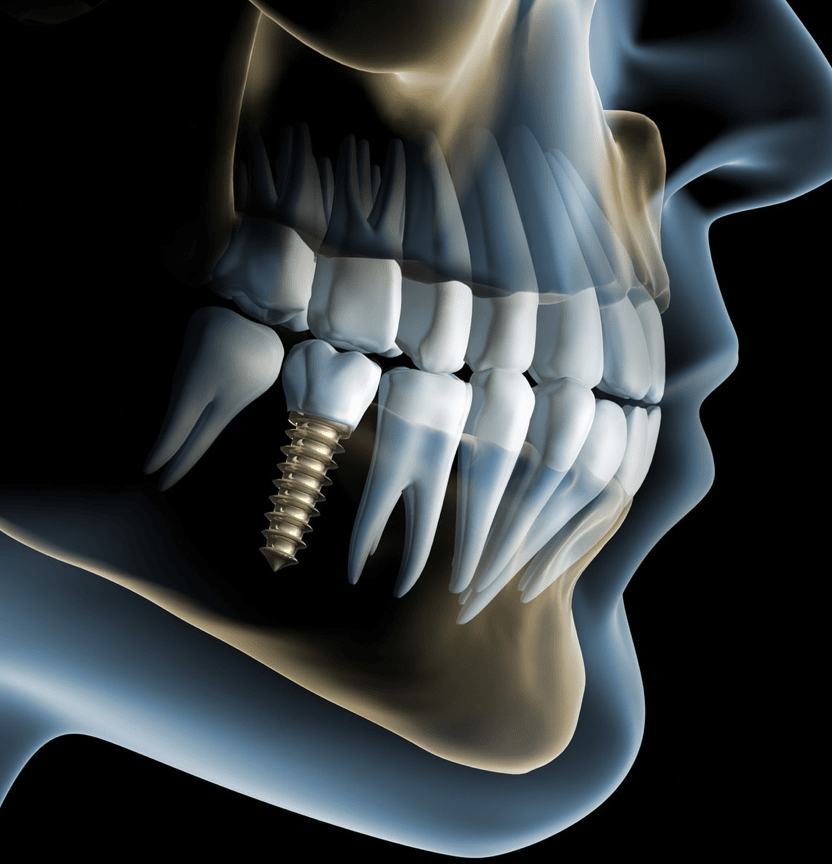
The buried and unburied implant after the uncovering stage
- Non-submerged implants : they are placed in the bone and have a smooth neck that passes through the gum. They receive their healing screw when they are placed. The gum is then sutured around the implant and its healing screw. Gingival healing takes place at the same time as the osseointegration of the implant.
- These implants are indicated in the posterior areas of the jaw and allow better access to oral hygiene techniques.Dental implants have been the subject of numerous scientific studies validating their safety and biological properties.
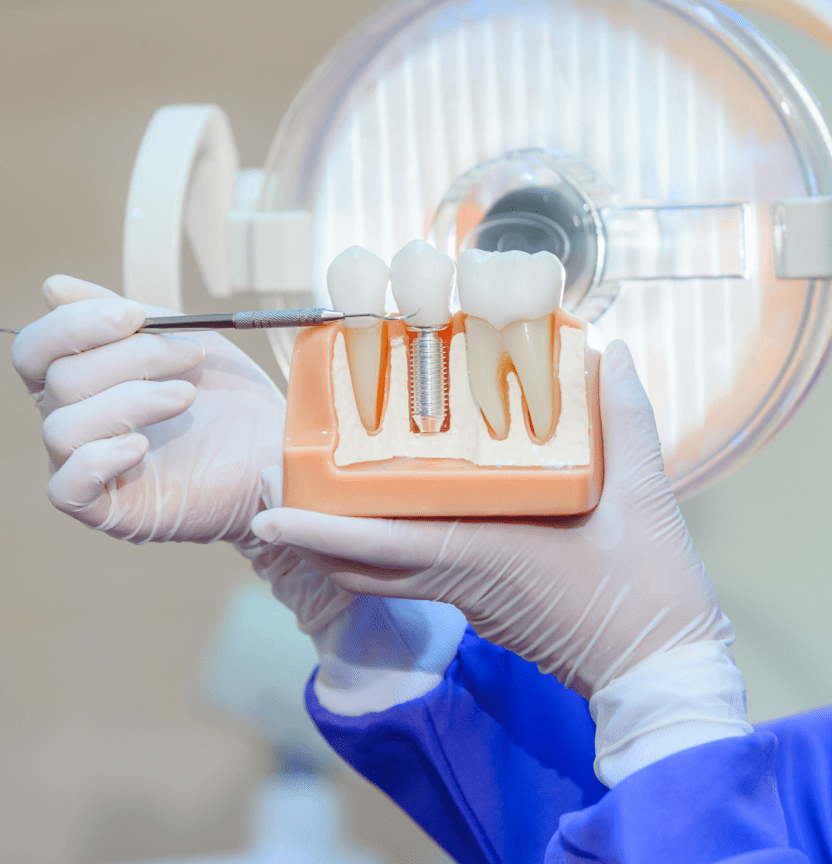
5. Bone grafting: when should it be done ?
There must be enough bone around the dental implant (screw form) to ensure that it is firmly anchored in the jaw. Unfortunately, it can happen that there is not enough bone in the jaw to ensure that the implant can be placed correctly.
This is why it is sometimes necessary to reconstruct the bone in height and/or thickness. The technical solutions applicable to compensate for the lack of bone are different depending on the nature of the lack (height and/or thickness) and its location in the oral cavity (upper or lower jaw, anterior or posterior sector).
- When the bone deficiency is important, the reconstruction procedure must precede the placement of the implant. A waiting period of 4 to 6 months is then necessary before the placement of the implant.
- When the bone deficiency is moderate, reconstruction and implant placement can be performed at the same time.
Pre-implant bone grafts are necessary to correct bone defects and loss of bone volume due to tooth extractions, infections or cysts.
A minimum amount of bone is required for the placement and durability of a dental implant.
In some cases of bone insufficiency, it is necessary to reconstruct the missing bone volumes.
A pre-implant bone graft (before the placement of the dental implant) or a peri-implant bone graft (at the same time as the placement of the implant) must then be performed.
The different techniques of bone reconstruction
Guided bone regeneration
It consists in placing the bone substitute in granules at the level of the bone defect. These granules are stabilised by a membrane which also has a protective role. In most cases, the dental implant is placed in the same operation as the bone regeneration. The gum is then replaced and sutured to close the surgical site.
Post-operative healing time is 4 to 6 months and allows for bone colonisation within the filling material and around the implant.
The bone biomaterials or bone substitutes used are of natural or synthetic origin depending on the indications. Additional information is provided by your practitioner during the pre-operative consultations. All the materials used have been the subject of scientific studies validating their harmlessness and their biological properties.
Sinus transplantation
Sinus filling is a bone reconstruction technique in the area of the maxillary premolars and molars (upper jaw). It allows the correction of bone deficiencies in height resulting from the loss of teeth and the increase in volume of the maxillary sinus (cavity containing air). It consists of filling in the sinus floor with a bone substitute, which is then pushed upwards. It can be done at the same time as the dental implant when the height to be reconstructed is low (2 to 4mm).
In cases of more important reconstruction (more than 4mm), the filling is done in a first step and followed by 6 to 8 months of healing before the placement of the dental implant.
There are two surgical techniques performed under local anaesthesia:
The crestal approach
- Access to the sinus is through the drill hole of the dental implant. The floor of the sinus is pushed upwards using special instruments called osteotomes. The filling material is inserted and the dental implant is placed in the same operation.
The gum is then sutured around the implant. Bone healing takes 4 to 6 months.
The lateral approach
- The sinus filling technique is validated by scientific studies and gives reproducible results.
- The sinus filling technique is validated by scientific studies and gives reproducible results.
Bone grafting
Appositional bone grafting is a technique for reconstructing large volume bone defects. It is most often indicated for thick bone reconstruction before placing dental implants. It is performed under local anaesthesia and consists of stabilising a bone block at the site to be reconstructed.
The technique of bone reconstruction by apposition graft :
After the gum has been detached, the bone block is adapted and stabilised with osteosynthesis screws that secure it to the jawbone. A protective collagen membrane is placed over the graft in some cases.
The gum is then replaced and sutured. A healing period of 4 to 6 months allows the bone to heal and the graft to fuse to the recipient site.
The dental implant is placed after the graft has healed and a radiographic check is made. The osteosynthesis screws are removed during the placement of the dental implant.
The control X-ray of an appositional bone graft :
A further healing period of 2 months allows the osseointegration of the dental implant. This technique has been validated by scientific studies for many years. The bone blocks used can come from the patient himself (autograft) or from a tissue bank (allograft).
In the case of autografts, bone is harvested from a buccal donor site, most often from the mandibular wisdom teeth (lower jaw).
Bone graft alternatives ?
In some cases, short or narrow dental implants can be used to avoid bone grafts. Recent technological advances have allowed the design of small implants with good mechanical properties.
However, they are not suitable for all low bone volume situations.
